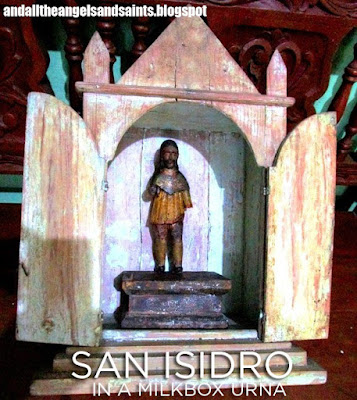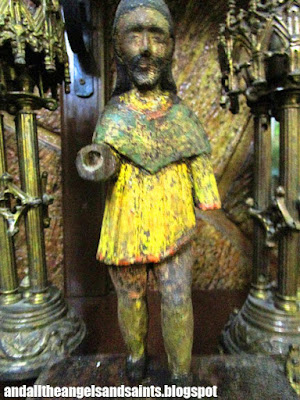One of the most quaint folk art pieces I acquired just has
to be this tiny San Isidro Labrador from Bohol, that was matched with a
hand-made wooden urna, fashioned from an old wooden milk crate.
 |
| SAN ISIDRO LABRADOR BOHOL SANTO, |
The century-old San Isidro—a shade over 5 inches, excluding
the base—is a typical Bohol piece with some of its brilliant polychromy still
intact, all iconographically correct. He wears a green cape over a yellow
tunic, with his boots on. He has missing hands, which once held a spade.
 |
| The santo stands a mere 5+ inches tall |
Despite the small rectangular base, there is a space once
occupied by an angel plowing with a cow. The figure of the kneeling landlord is
an optional element of the tableau, and he was left out in this representation,
understandably because of the small dimension of the piece.
Ordinarily, Bohol pieces were enshrined in folk urnas of the
same qualities as the santo---small, brightly polychromed wooden altars
embellished with relief carvings, raised by stair-shaped bases. This San
Isidro, however, was found being displayed in an antique shop in a simple
wooden urna, which stylistically does not match the Bohol style, but fits the
santo’s size perfectly.
 |
| Wooden urna, handcrafted from milk crate |
The small urna was ingeniously handcrafted from a milk
crate—and the brand name can be found at the bottom of the urna to hide it—“Milkmaid
Brand, Sweetened Condensed Milk".
Milkmaid was an imported milk product, and it was first launched in the Philippines in the 1920s. By the 1930s, it was a successful brand, popularly known as “Marca Señorita”, because of the milkmaid brand character.
 |
| Old Milkmaid ad, 1929 |
It was heavily advertised and promoted, and in 1929, Milkmaid even sponsored the search for the healthiest and cutest babies of the Philippines.
The urna itself, though simple in its creation, has many
charming details. The “pediment’ is flanked by two “fence peg” spires. The
double doors are hinged with wires, which were also used to make the latch. The
boxy structure was attached to a 3-step stair base.
Its coating of white gesso or paint are still visible on the surface. Similar urnas made from commercial wooden crates were usually embellished with painted designs to make up for their plainness, but this example has no traces of color that I can see. In any case, San Isidro seems to be happy in his simple abode—after all, as a humble farmer-saint, he is used to a much harsher environment!









No comments:
Post a Comment